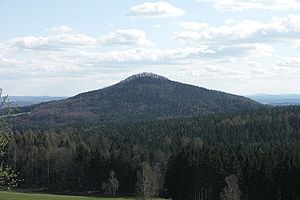Sokol (Lusatian Mountains)
| Sokol | ||
|---|---|---|
|
Sokol (Falkenberg) as seen from Lückendorf |
||
| height | 592.5 m nm | |
| location | Czech Republic | |
| Mountains | Lusatian Mountains | |
| Coordinates | 50 ° 48 '25 " N , 14 ° 45' 0" E | |
|
|
||
| Type | Kegelberg | |
| rock | Phonolite | |
| particularities | "Alt Falkenburg" castle ruins on the summit | |
The Sokol ( German Falkenberg ) is due to its conical shape one of the most striking mountains in the Lusatian Mountains (592.5 m). On the top there are the small remains of the Starý Falkenburk Castle (Old Falkenburg) .
Location and surroundings
The phonolite cone is located approx. 1.2 km west of Petrovice (Petersdorf) or 2.7 km southwest of Lückendorf not far from the border with Germany. The closest mountain peaks are those of the high forest and the Jezevčí vrch (Limberg) . The area around Sokol is heavily forested, mainly mixed forest. In the spring, the hollow lark's spur blooms in the summit area , spreading a carpet of flowers in red and white.
The remains of the Starý Falkenburk castle complex are barely noticeable on its summit.
The Hermanicky Potok (Hermsdorfer Bach) rises to the west of the mountain and drains to the south. To the north are the remains of former iron ore mines.
Castle history
The exact time when the Falkenburg was built on the summit of Sokol is lost in history. The castle was first mentioned in 1415, when Albrecht von Dönis was recorded as the owner. The castle probably served to protect the trade route from Zittau to Jablonné (German fork).
During the Hussite Wars, the Hussite castle garrison robbed the area. In 1431 the Upper Lusatian Union of Six Cities destroyed the castle for the first time, but it was quickly rebuilt. In 1434, after the Battle of Lipan , the lords of the castle refused to reconcile with the Union of Six Cities, whereupon Emperor Sigismund ordered the Zittauers to destroy the castle. In 1437 it was rumored that the castle had burned down through carelessness. This fact is seen as a ruse to prevent complete destruction. Nikolaus Falke von Lamberg later took over the castle, which had already been rebuilt, before it was finally destroyed by the Six Cities Association in 1467. It served as a hiding place for gangs of robbers for some time, but was already considered desolate in 1513.
Today you can only see some remains of the curtain wall and the foundation walls of the stronghold.
view
The summit area is covered with beeches, so that a partial view is only possible in the leafless season. However, during the ascent over clearings, there are views of the mountains of the Lusatian Mountains, especially in the north.
literature
- Andreas Bültemeier: Hikes in the Lusatian Mountains and the Bohemian Netherlands ; Oberlausitzer Verlag Spitzkunnersdorf; ISBN 3-933827-29-9 .


